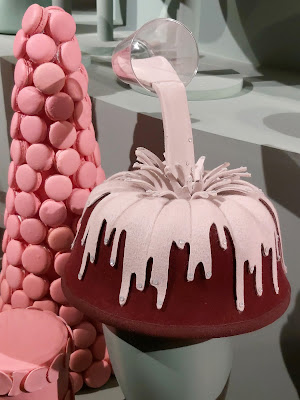The exhibition is divided into four sections. We began our visit in the Lower Gallery of the museum where a historical timeline of garments, "Re-sewing the
History of the Ball", featured reconstructions of historical pieces. Designed with historical accuracy by
the costume historian and creator Moni Mednik, the all white cotton
muslin garments demonstrated the changes in the design of ball gowns and
evening wear as they evolved from the 18th century, through the world wars,
the Great Depression and up to the 80s.
We moved on to "The Whipping Room and the Mad Hatter", a stunning installation which brought together the works of the hatter Maor Zabar and the pastry chef
Alon Shabo. The exhibition was intended as a playful look at the desserts that
added a sweet touch to the balls. On display were 23 towers consisting
of about 6,500 macaroons, 122 wedding cakes, tiered cakes and personal
desserts, hand-sculpted from 500 kilos of sugar, almond powder, as well as
cement and Styrofoam! All the dessert sculptures on display were handmade over
1,000 hours.
Zabar's hats were all handmade and inspired by desserts such as a toffee
apples, Black Forest gâteau and candyfloss. A fashion designer by
training, Zabar used unconventional materials, extreme proportions and
angles that challenge gravity in the design of the 15 hats exhibited. They
combined humour with surrealism and were a delight to see!
Then we went upstairs, to the Upper Gallery of the Design Museum, where "The Modern Ball: Israeli Couture" was on display. This section of the exhibition offered a glimpse into Israel's evening-wear industry through bridal gowns and evening gowns made by leading designers in the country. The curator of the exhibition, Yaara Keydar, wanted to show that the ball is no longer limited to Europe. It was important for her to include the Israeli perspective on proms and balls as well.
Lihi Hod, Shlomi Anteby, Maya Naé, "If You Will It, It Is A Fairy Tale."
The 82 dresses on display show the scope of the industry in Israel, which is at international standards. Even though we are in the Middle East, you could clearly see European history through the dresses, through puffed sleeves, crinoline and corsets. Highlights included dresses designed by Alon Livne and worn by Lady Gaga and Katy Perry and a dress sewn from 15,000 old Israeli coins designed by Shai Shalom. Other striking designs included the Israeli musician Ninet Tayeb's wedding dress, designed by Victor Vivi Bellaish and Gadi Elimelech, colourful tulle dresses designed by Shahar Avnet, a digitally printed wedding dress designed by Lihi Hod, as well as a modest, ultra-Orthodox gown by Brurya Haritan.
The opening of the exhibition was postponed several times due to the pandemic. It finally opened in July but was definitely worth the wait! The design and colour of the displays were such a treat and I especially loved Maor Zabar's dessert hats.
"The Ball" is on display at the Design Museum Holon until December 11th.











































































